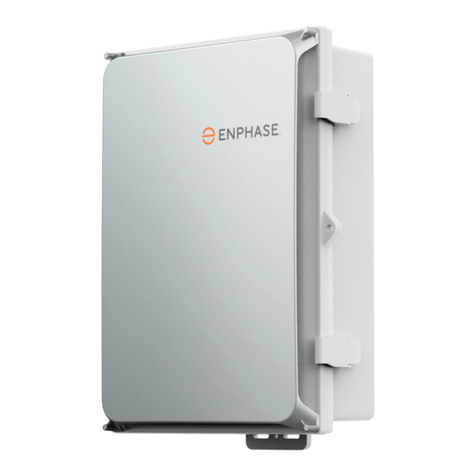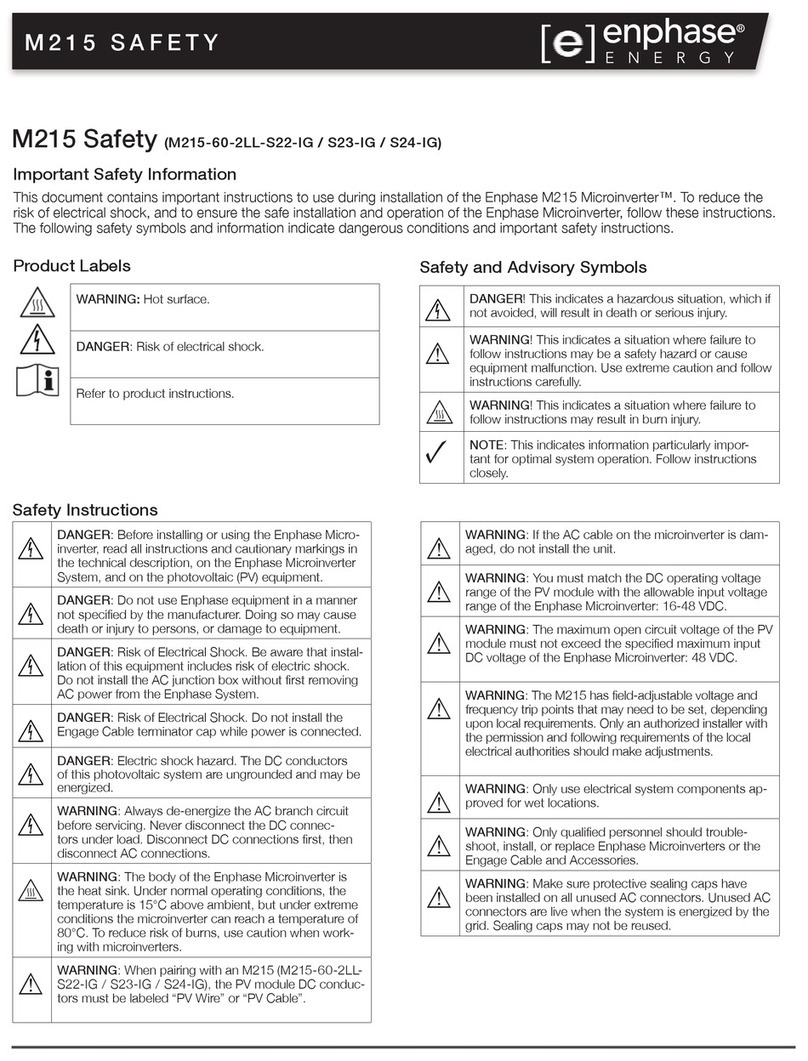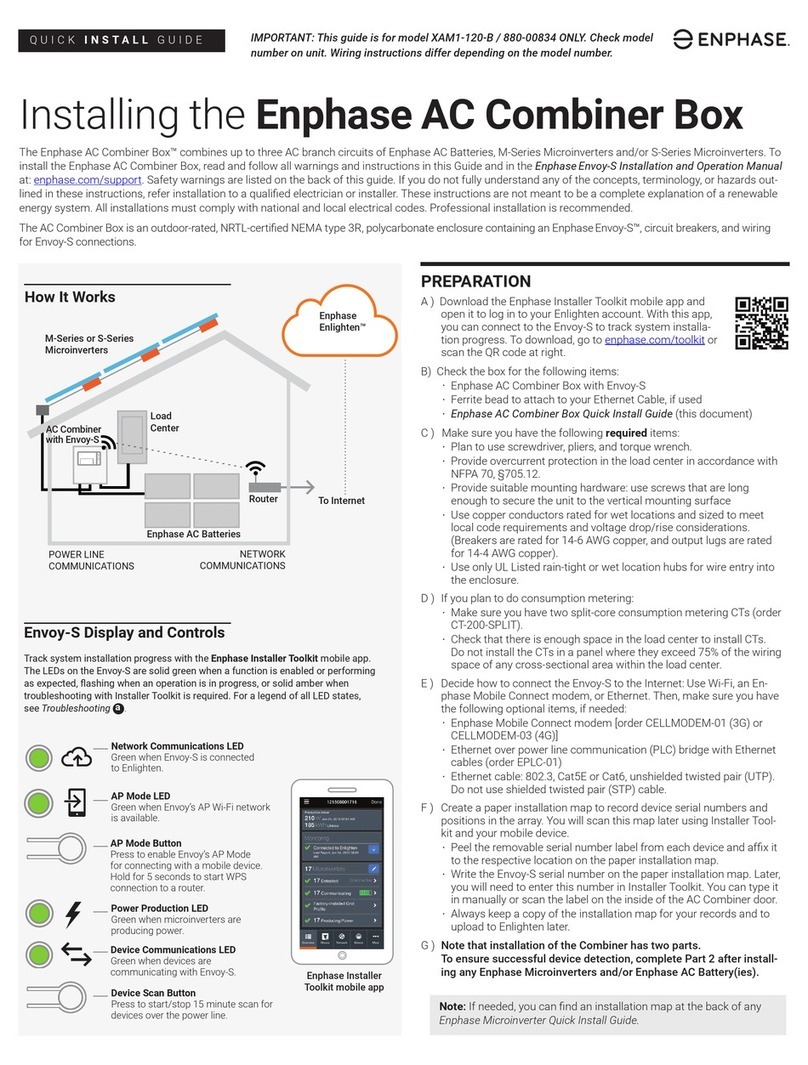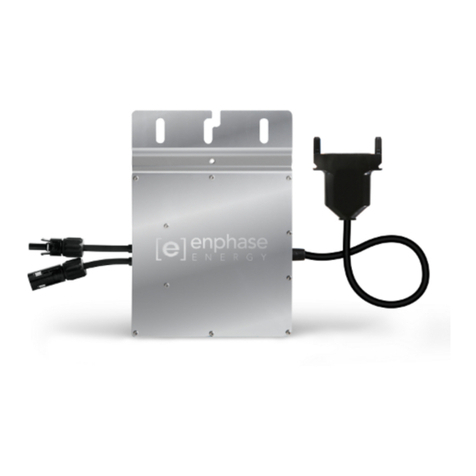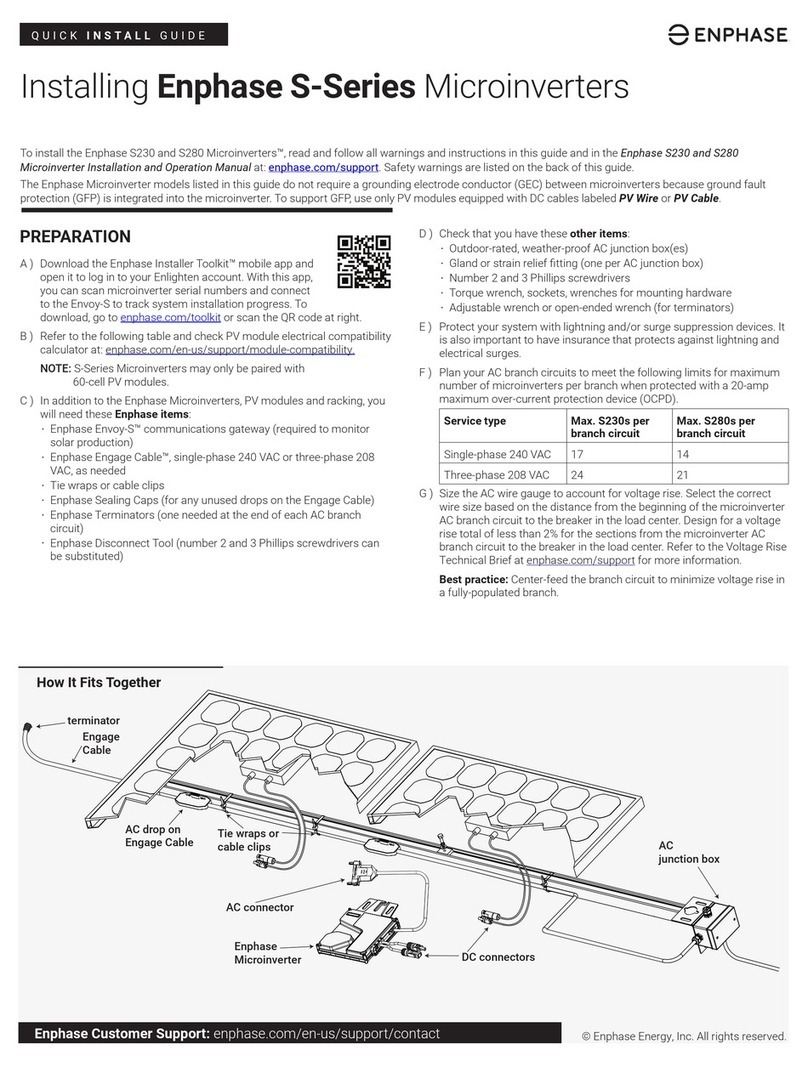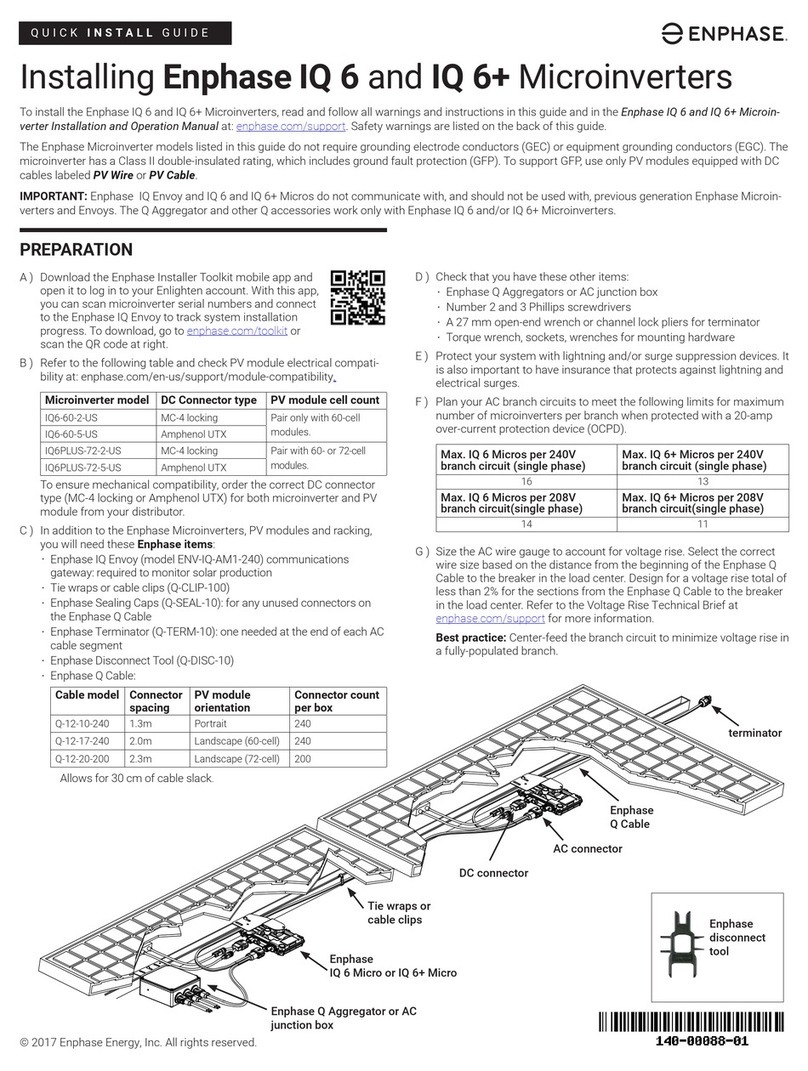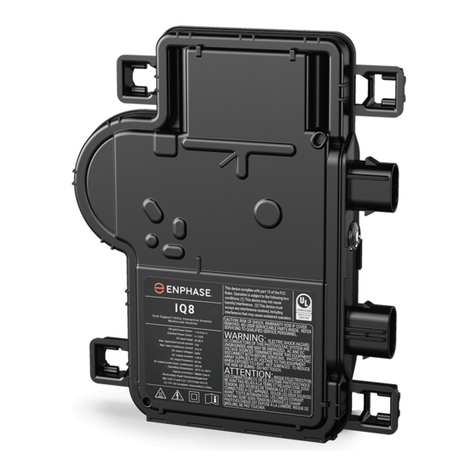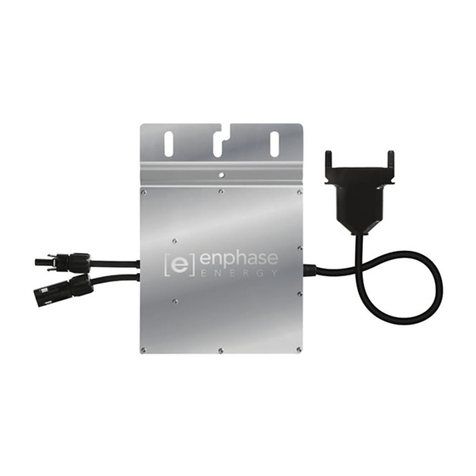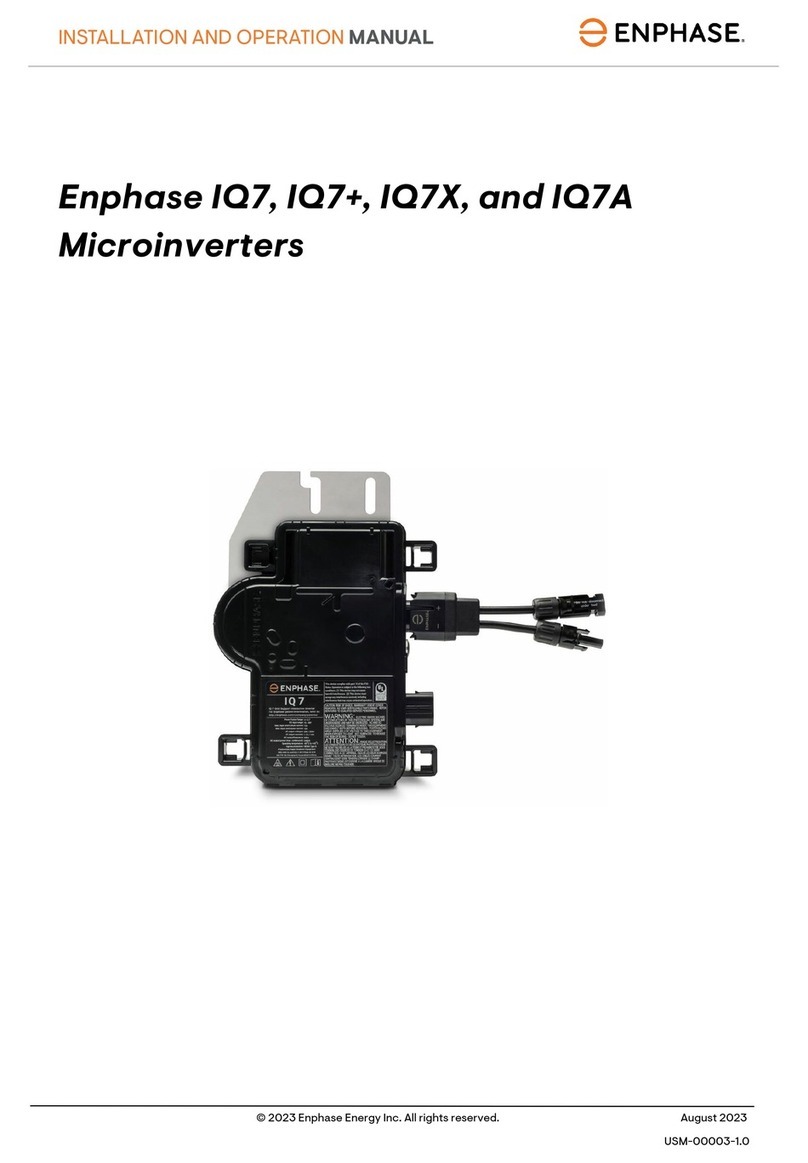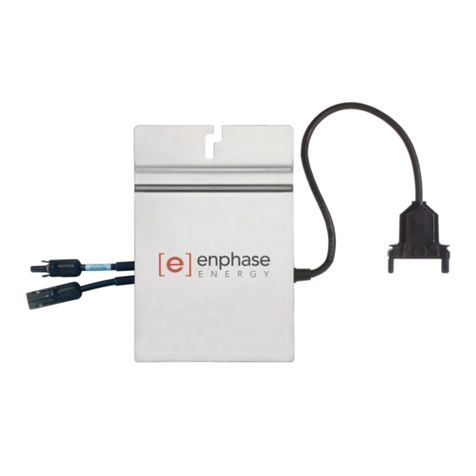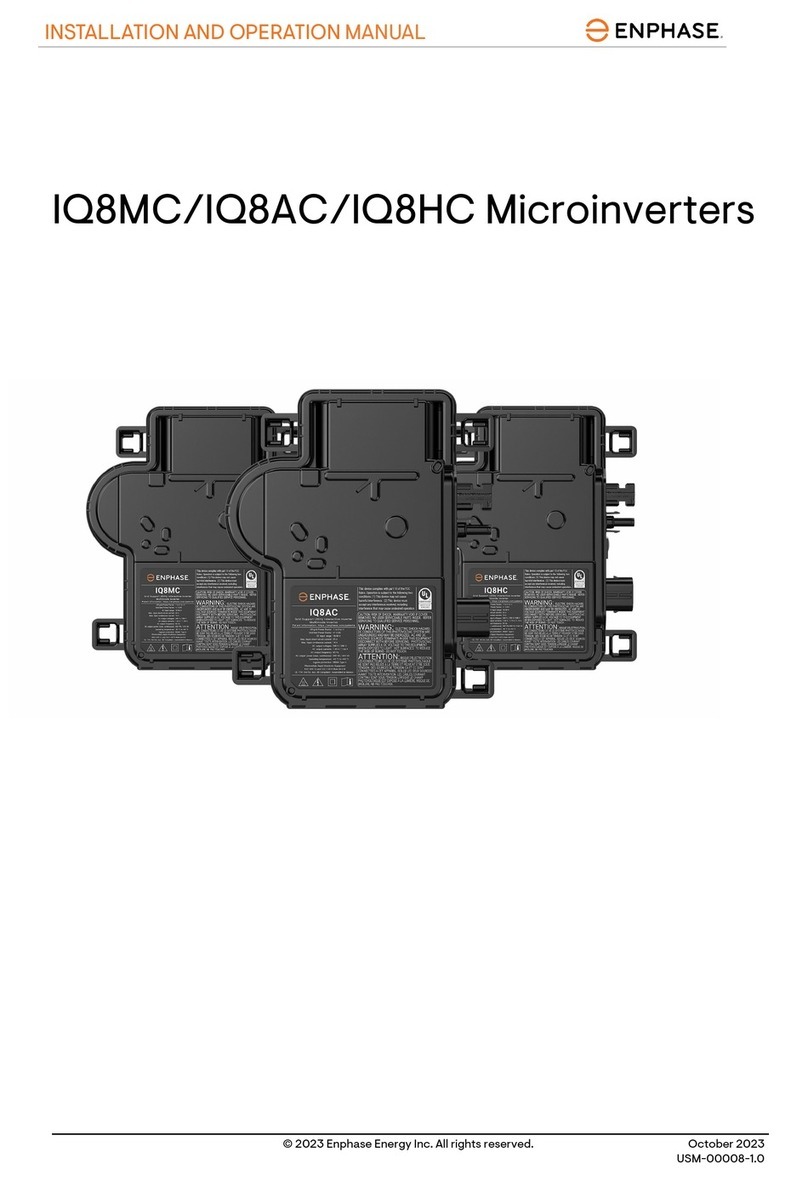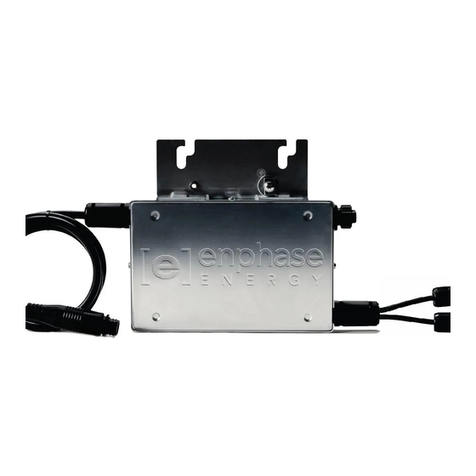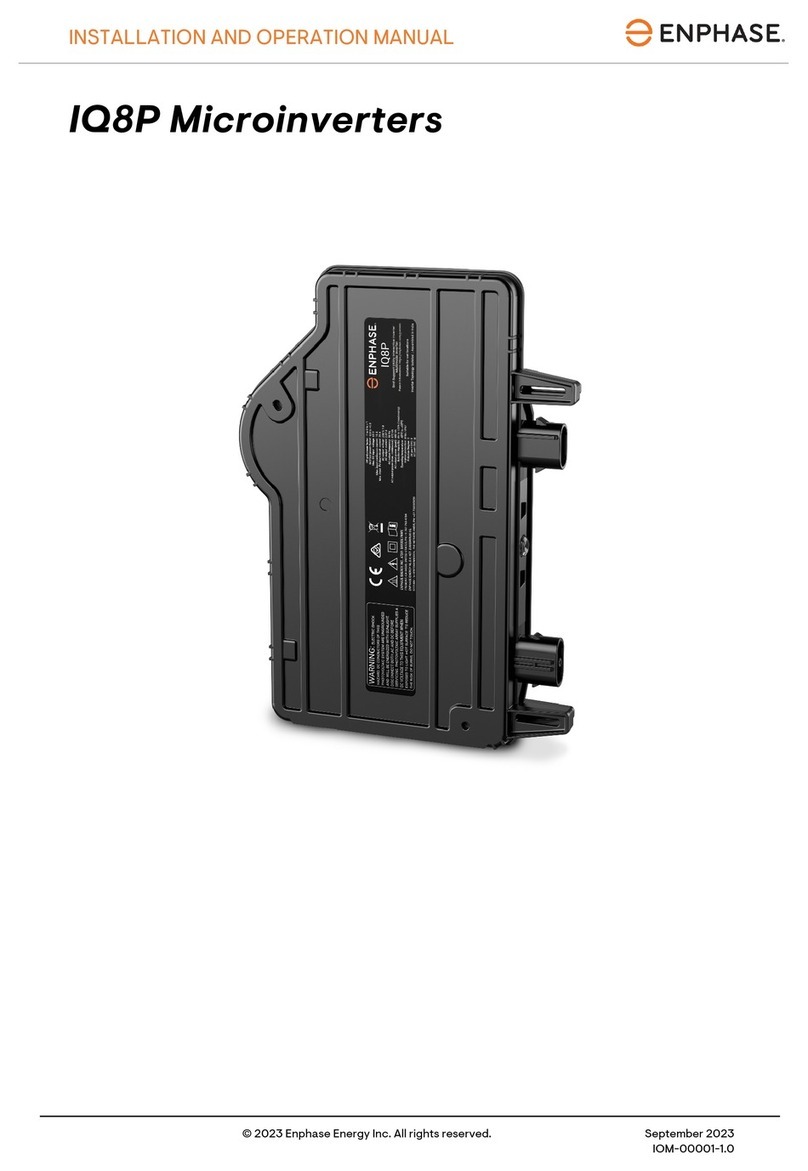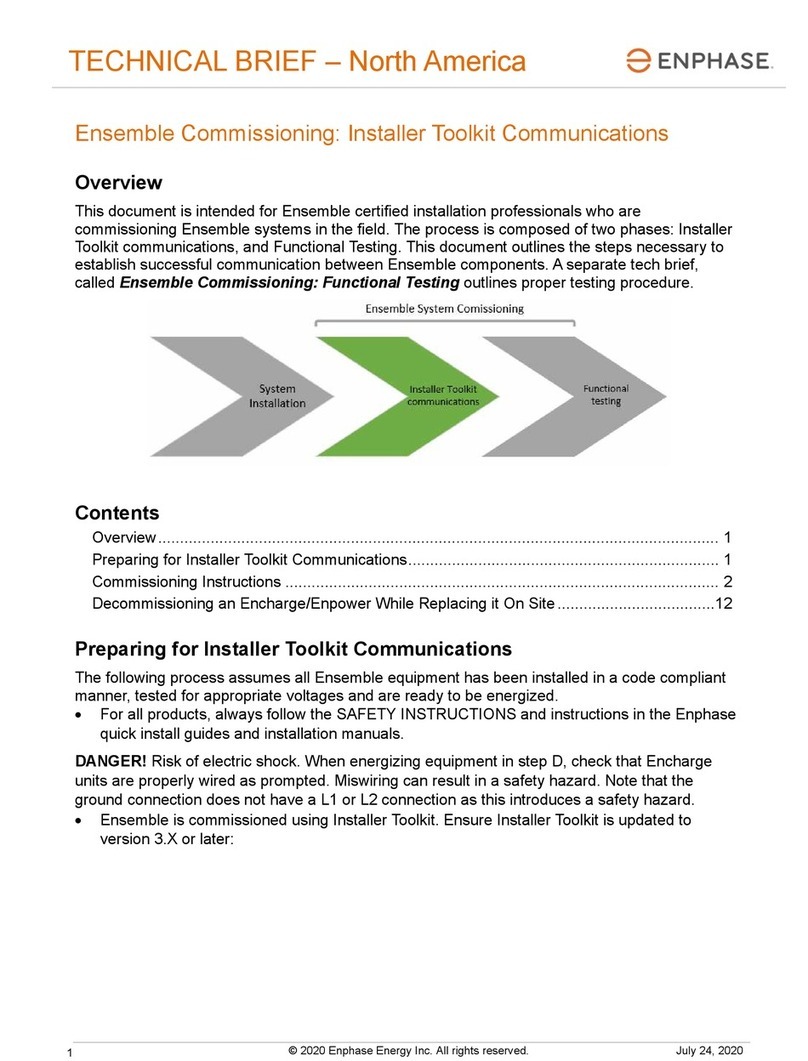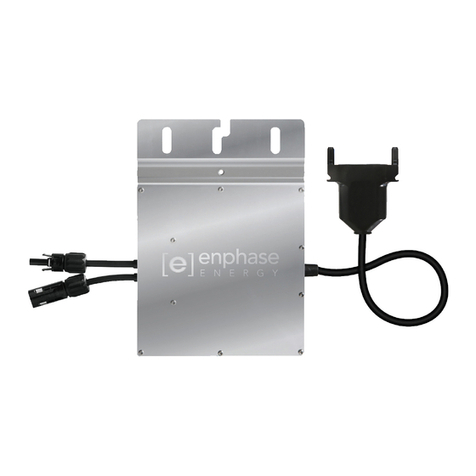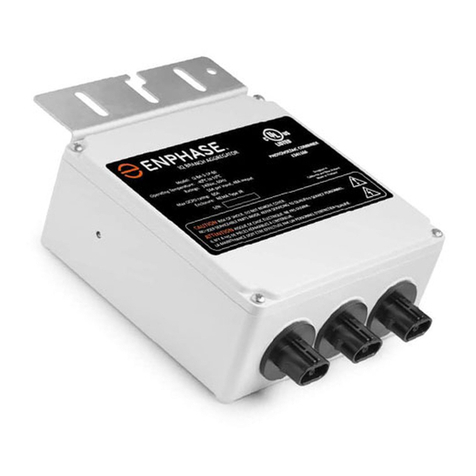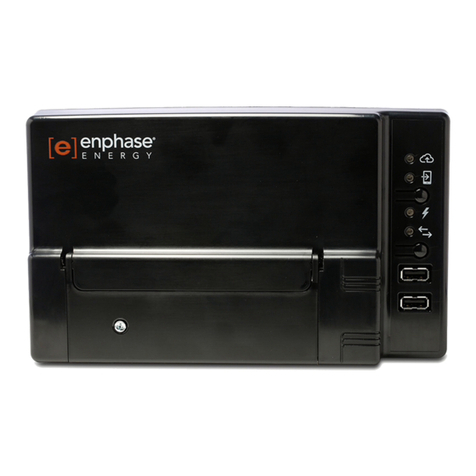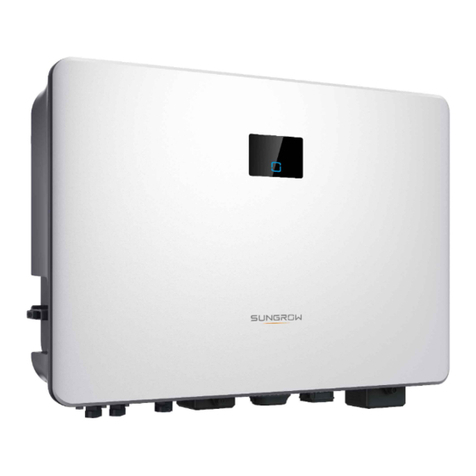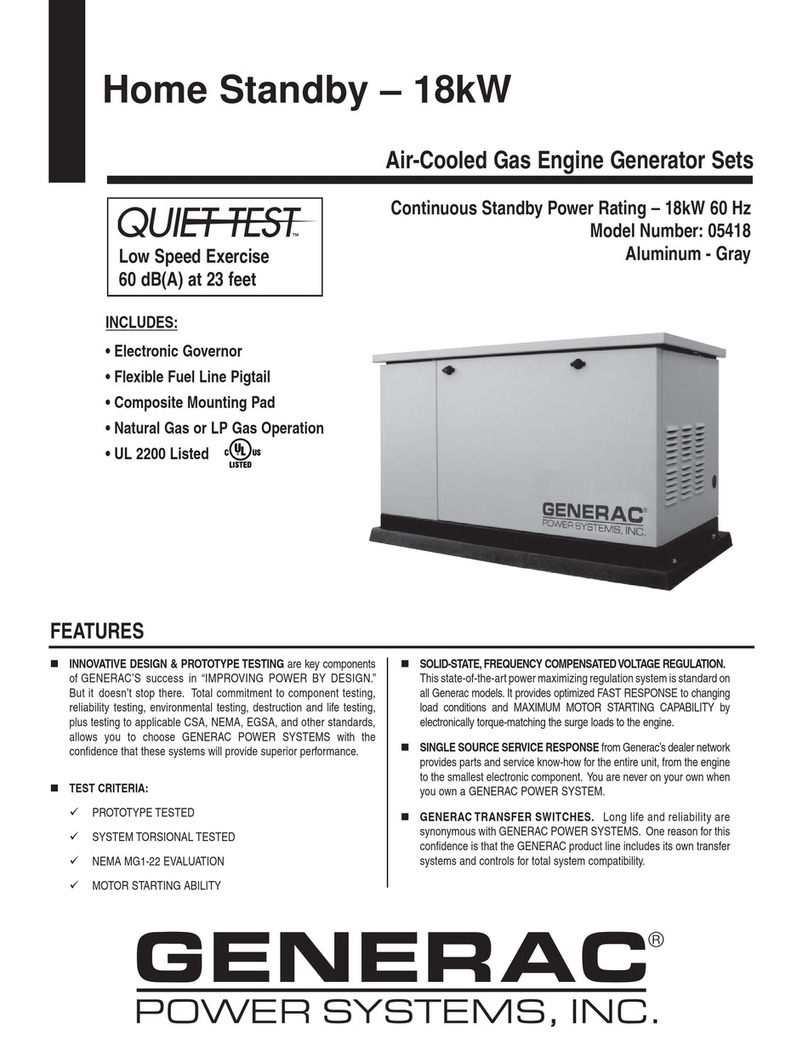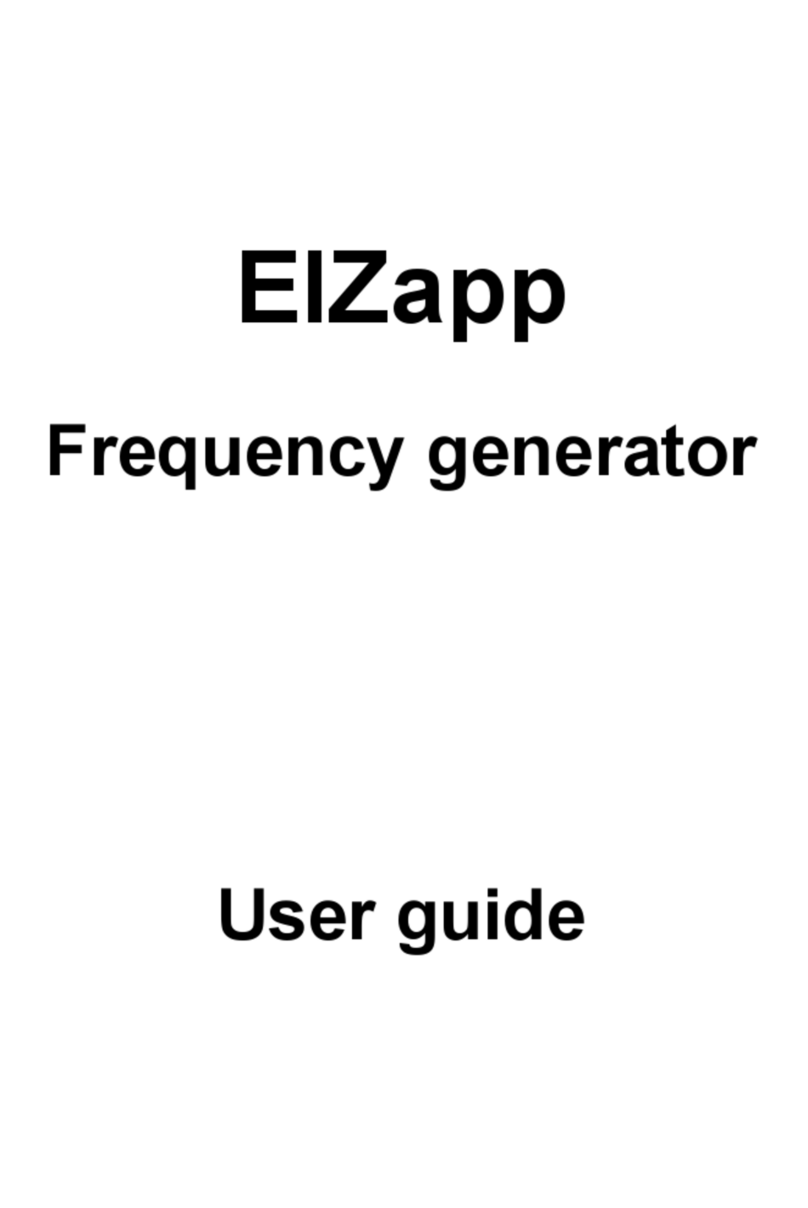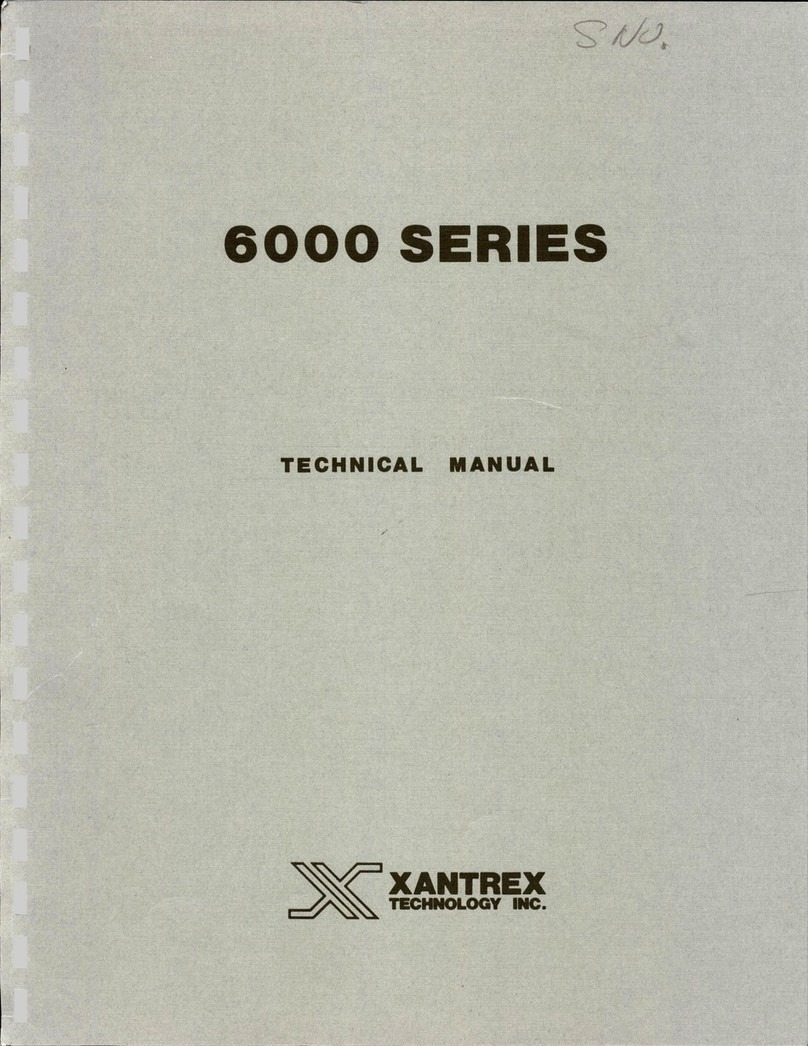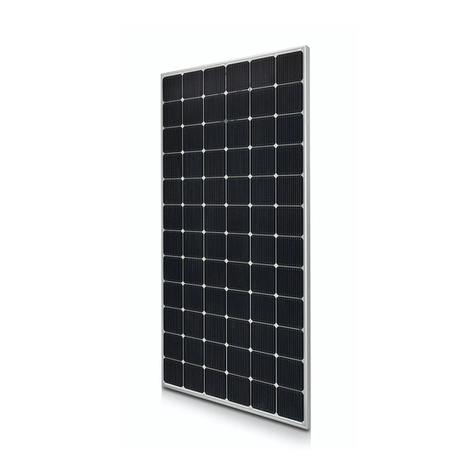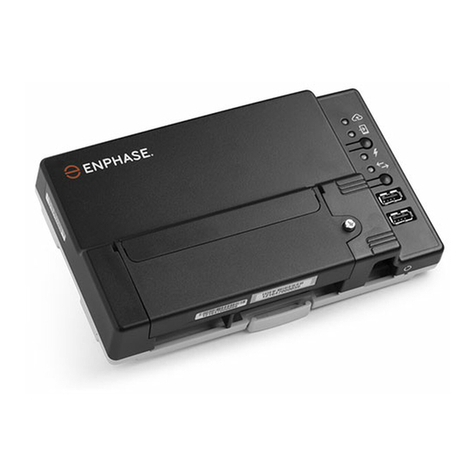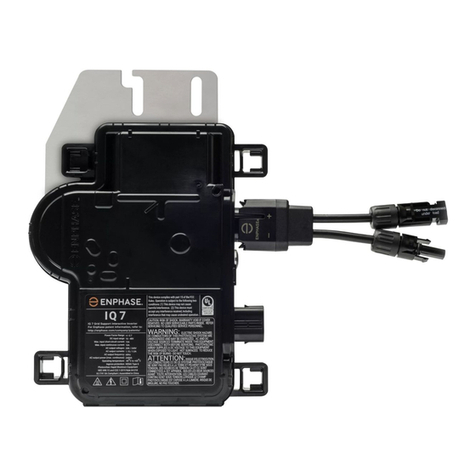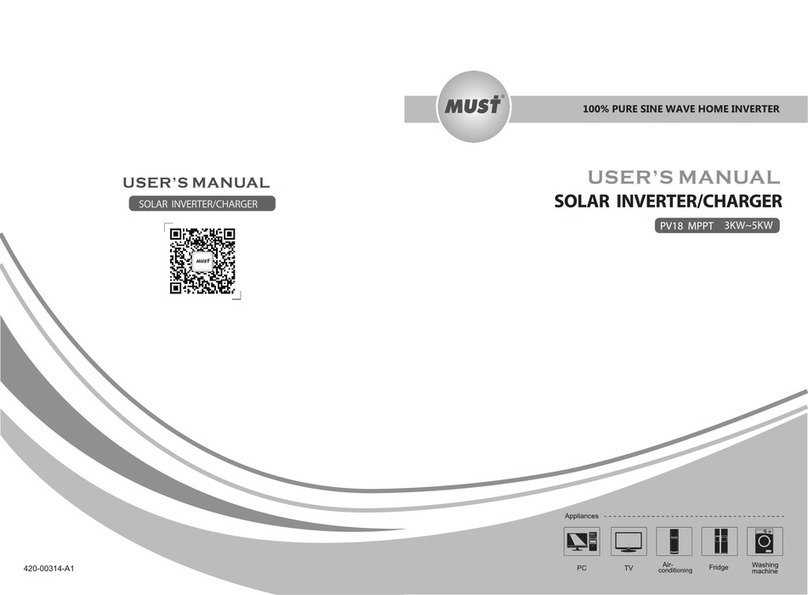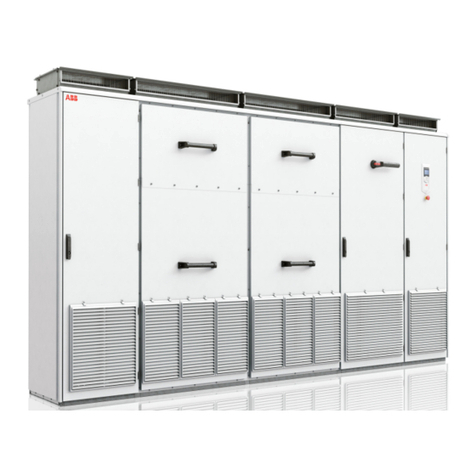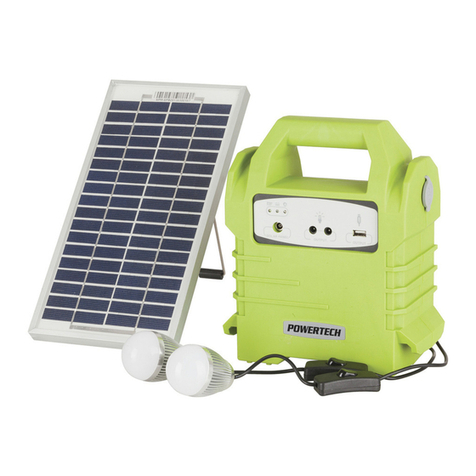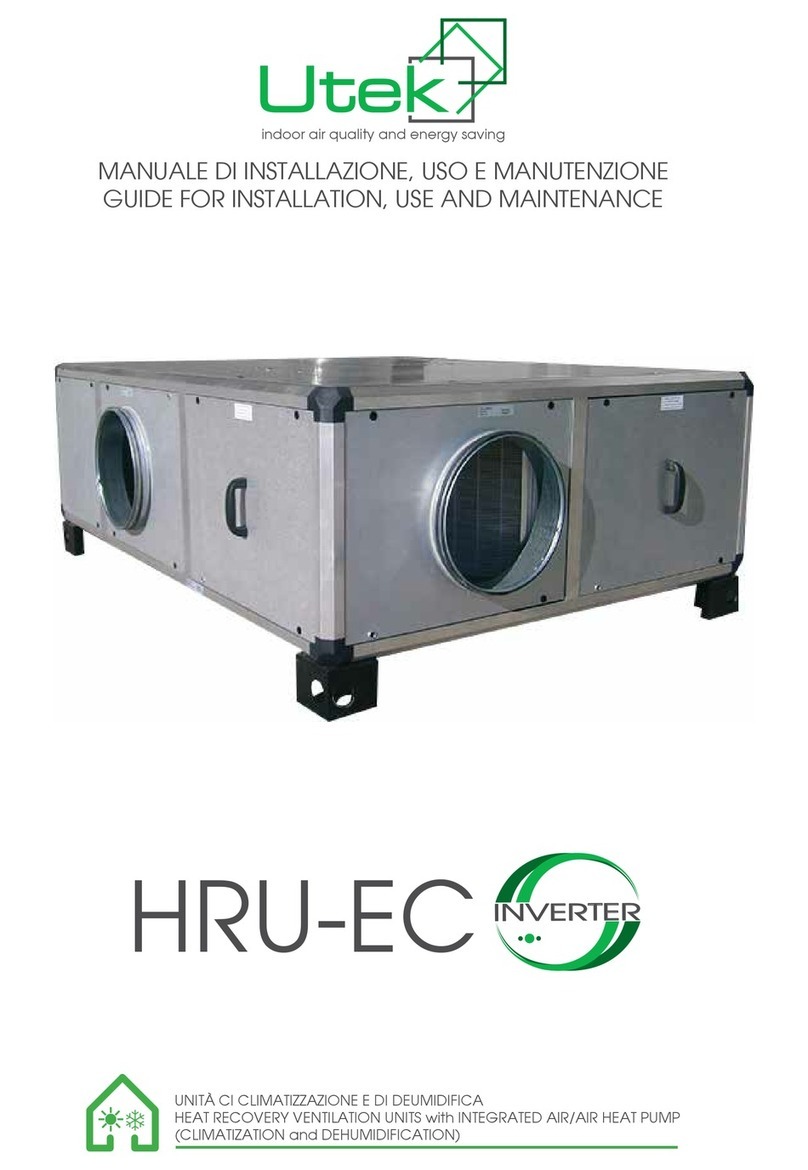SAFETY
IMPORTANT SAFETY INSTRUCTIONS
SAVE THIS INFORMATION. This guide con-
tains important instructions to follow during installation of
the Enphase IQ 7, IQ 7A, IQ 7+, and IQ7X Microinverters.
WARNING: Hot surface.
WARNING: Refer to safety instructions.
DANGER: Risk of electric shock.
Refer to manual
Double-Insulated
General Safety
+DANGER: Risk of electric shock. Do not
use Enphase equipment in a manner not
specied by the manufacturer. Doing so
may cause death or injury to persons, or
damage to equipment.
+DANGER: Risk of electric shock. Be aware that
installation of this equipment includes risk of
electric shock.
+DANGER: Risk of electric shock. The DC
conductors of this photovoltaic system are
ungrounded and may be energised.
+DANGER: Risk of electric shock. Always
de-energise the AC branch circuit before ser-
vicing. Never disconnect the DC connectors
under load.
+DANGER: Risk of electric shock. Risk of re.
Only use electrical system components
approved for wet locations.
+DANGER: Risk of electric shock. Risk
of re. Only qualied personnel should
troubleshoot, install, or replace Enphase
Microinverters or the Enphase Q Cable and
Accessories.
+DANGER: Risk of electric shock. Risk of re.
Ensure that all AC and DC wiring is correct and
that none of the AC or DC wires are pinched
or damaged. Ensure that all AC junction boxes
are properly closed.
+DANGER: Risk of electric shock. Risk of
re. Do not exceed the maximum number
of microinverters in an AC branch circuit
as listed in this guide. You must protect
each microinverter AC branch circuit with
a 20A (single-phase) or 25A (three-phase)
maximum breaker or fuse, as appropriate.
+DANGER: Risk of electric shock. Risk of re.
Only qualied personnel may connect the
Enphase Microinverter to the utility grid.
*WARNING: Risk of equipment damage.
Enphase male and female connectors must
only be mated with the matching male/female
connector.
*WARNING: Before installing or using the
Enphase Microinverter, read all instructions
and cautionary markings in the technical
description, on the Enphase Microinverter
System, and on the photovoltaic (PV)
equipment.
Microinverter Safety
+DANGER: Risk of electric shock. Risk of
re. Do not attempt to repair the Enphase
Microinverter; it contains no user-ser-
viceable parts. If it fails, contact Enphase
customer service to obtain an RMA (return
merchandise authorisation) number and
start the replacement process. Tampering
with or opening the Enphase Microinverter
will void the warranty.
+DANGER: Risk of re. The DC conductors of
the PV module must be labeled “PV Wire”
or “PV Cable” when paired with the Enphase
Microinverter.
*WARNING: You must match the DC
operating voltage range of the PV module
with the allowable input voltage range of the
Enphase Microinverter.
*WARNING: The maximum open circuit
voltage of the PV module must not exceed
the specied maximum input DC voltage of
the Enphase Microinverter.
*WARNING: Risk of equipment damage. In-
stall the microinverter under the PV module
to avoid direct exposure to rain, UV, and
other harmful weather events. Always install
the microinverter bracket side up. Do not
mount the microinverter upside down. Do
not expose the AC or DC connectors (on the
Enphase Q Cable connection, PV module, or
the microinverter) to rain or condensation
before mating the connectors.
*WARNING: Risk of equipment damage. The
Enphase Microinverter is not protected from
damage due to moisture trapped in cabling
systems. Never mate microinverters to
cables that have been left disconnected and
exposed to wet conditions. This voids the
Enphase warranty.
*WARNING: Risk of equipment damage. The
Enphase Microinverter functions only with
a standard, compatible PV module with
appropriate ll-factor, voltage, and current
ratings. Unsupported devices include smart
PV modules, fuel cells, wind or water turbines,
DC generators, and non-Enphase batteries, etc.
These devices do not behave like standard PV
modules, so operation and compliance is not
guaranteed. These devices may also damage
the Enphase Microinverter by exceeding its
electrical rating, making the system potentially
unsafe.
;WARNING: Risk of skin burn. The chassis
of the Enphase Microinverter is the heat
sink. Under normal operating conditions,
the temperature could be 20°C above
ambient, but under extreme conditions the
microinverter can reach a temperature of
90°C. To reduce risk of burns, use caution
when working with microinverters.
✓NOTE: The Enphase Microinverter has
eld-adjustable voltage and frequency trip
points that may need to be set, depending
upon local requirements. Only an authorised
installer with the permission and following
requirements of the local electrical authorities
should make adjustments.
Enphase Q Cable Safety
+DANGER: Risk of electric shock. Do not
install the Enphase Q Cable terminator while
power is connected.
+DANGER: Risk of electric shock. Risk of
re. When stripping the sheath from the
Enphase Q Cable, make sure the conductors
are not damaged. If the exposed wires are
damaged, the system may not function
properly.
+DANGER: Risk of electric shock. Risk of re.
Do not leave AC connectors on the Enphase
Q Cable uncovered for an extended period.
You must cover any unused connector with
a sealing cap.
+DANGER: Risk of electric shock. Risk of re.
Make sure protective sealing caps have been
installed on all unused AC connectors. Unused
AC connectors are live when the system is
energised.
*WARNING: Use the terminator only once. If
you open the terminator following installation,
the latching mechanism is destroyed. Do
not reuse the terminator. If the latching
mechanism is defective, do not use the
terminator. Do not circumvent or manipulate
the latching mechanism.
*WARNING: When installing the Enphase Q
Cable, secure any loose cable to minimise
tripping hazard
✓NOTE: The Enphase Microinverter models
listed in this guide do not require grounding
electrode conductors (GEC), equipment
grounding conductors (EGC), or grounded
conductor (neutral). The microinverter has
a Class II double-insulated rating, which
includes ground fault protection (GFP). To
support GFP, use only PV modules equipped
with DC cables labeled PV Wire or PV Cable.
✓NOTE: When looping the Enphase Q Cable,
do not form loops smaller than 12 cm in
diameter.
✓NOTE: If you need to remove a sealing cap,
you must use the Enphase disconnect tool.
✓NOTE: When installing the Enphase Q Cable
and accessories, adhere to the following:
• Do not expose the terminator or cable
connections to directed, pressurised liquid
(water jets, etc.).
• Do not expose the terminator or cable
connections to continuous immersion.
• Do not expose the terminator or cable
connections to continuous tension (e.g.,
tension due to pulling or bending the cable
near the connection).
• Use only the connectors and cables
provided.
• Do not allow contamination or debris in the
connectors.
• Use the terminator and cable connections
only when all parts are present and intact.
• Do not install or use in potentially explosive
environments.
• Do not allow the terminator to come into
contact with open ame.
• Fit the terminator using only the prescribed
tools and in the prescribed manner.
• Use the terminator to seal the conductor
end of the Enphase Q Cable; no other
method is allowed.
Safety Symbols
+DANGER: Indicates a hazardous situation,
which if not avoided, will result in death or
serious injury.
*WARNING: Indicates a situation where
failure to follow instructions may be a safety
hazard or cause equipment malfunction.
Use extreme caution and follow instructions
carefully.
;WARNING: Indicates a situation where
failure to follow instructions may result in
burn injury.
✓NOTE: Indicates information particularly
important for optimal system operation.
*WARNING: Do not connect Enphase
Microinverters to the grid or energise the AC
circuit(s) until you have completed all of the
installation procedures and have received
prior approval from the electrical utility
company.
General Safety, continued
*WARNING: When the PV array is exposed to
light, DC voltage is supplied to the PCE.
*WARNING: Incorrect phase wiring
can cause irreversible damage to the
microinverter installation. Check all wiring
before energising.
✓NOTE: To ensure optimal reliability and to
meet warranty requirements, install the
Enphase Microinverters and Enphase Q
Cable according to the instructions in this
guide.
✓NOTE: Provide support for the Enphase Q
Cable at least every 1.8 m.
✓NOTE: Perform all electrical installations
in accordance with all applicable local
electrical codes.
✓NOTE: The AC and DC connectors on the
cabling are rated as a disconnect only when
used with an Enphase Microinverter.
✓NOTE: Protection against lightning and re-
sulting voltage surge must be in accordance
with local standards.
Enphase Customer Support: http://enphase.com/global/contact
© 2021 Enphase Energy. All rights reserved. Enphase, the
Enphase logo, Enphase IQ 7, Enphase Installer Toolkit, En-
phase Enlighten, Enphase IQ Envoy, and other trademarks
or service names are the trademarks of Enphase Energy,
Inc. Data subject to change. Rev03-09-27-2021.
Manage the Cabling
A ) Use cable clips or tie wraps to attach the
cable to the racking. The cable must be
supported at least every 1.8 m (6 feet).
B ) Dress any excess cabling in loops so
that it does not contact the roof. Do not
form loops smaller than 12 cm (4.75
inches) in diameter.
Create an Installation Map
Create a paper installation map to record microinverter serial numbers
and position in the array.
A ) Peel the removable serial number label from each microinverter
and afx it to the respective location on the paper installation map.
B ) Peel the label from the IQ Envoy and afx it to the installation map.
C ) Always keep a copy of the installation map for your records.
Mount the Microinverters
A ) Mount the microinverter horizontally bracket side up or vertical.
Always place it under the PV module, protected from direct exposure
to rain, sun, and other harmful weather events. Allow a minimum
of 1.9 cm (3/4”) between the roof and the microinverter. Also allow
1.3 cm (1/2”) between the back of the PV module and the top of the
microinverter.
For vertical mount also maintain >30 cm (12”) clearance from the
edges of the PV module to protect the microinverter from direct
exposure to rain, UV, and other harmful weather events.
B ) Torque the mounting fasteners (1/4-inch or 5/16-inch) as follows.
Do not over torque.
• 6 mm (1/4 inches) mounting hardware: 5 N m (45 to 50 in-lbs)
• 8 mm (5/16 inches) mounting hardware: 9 N m (80 to 85 in-lbs)
• When using UL 2703 mounting hardware, use the manufacturer’s
recommended torque value
3
6
5
4
INSTALLATION
Position the Enphase Q Cable
A ) Plan each cable segment to allow connectors on the Enphase Q Cable
to align with each PV module. Allow extra length for slack, cable turns,
and any obstructions.
B ) Mark the approximate centers of each PV module on the PV racking.
C ) Lay out the cabling along the installed racking for the AC branch circuit.
D ) Cut each segment of cable to meet your planned needs.
1
Position the Enphase Q Aggregator or Junction Box
A ) Verify that AC voltage at the site is within range:
Service Type and Voltage: L1 - L2
240 V single phase 211 to 264 VAC
208 V single phase 183 to 229 VAC
B ) Install an Enphase Q Aggregator or junction box at a suitable location on
the racking. See Enphase Q Aggregator Quick Install Guide.
C ) Provide an AC connection from the Enphase Q Aggregator or junction
box back to the electricity network connection using equipment and
practices as required by local jurisdictions.
2
Afx serial number labels
Connect the Microinverters
A ) Connect the microinverter. Listen for a click as the connectors
engage.
B ) Cover any unused connectors on the AC cable with Enphase
Sealing Caps. Listen for a click as the sealing caps engage.
To remove a sealing cap or AC connector, you must use an Enphase
disconnect tool.
WARNING: Install sealing caps on all unused AC connectors as
these connectors become live when the system is energized.
Sealing caps are required for protection against moisture ingress.
WARNING: When transitioning between rows, secure the cable to
the rail to prevent cable or connector damage. Do not count on the
connector to withstand tension.
WARNING: Install the microinverter under the PV module to avoid
direct exposure to rain, UV, and other harmful weather events. Do
not mount the microinverter upside down.
Horizontal mount:
DC connector
AC connector
Terminate the Unused End of the Cable
A ) Remove 13 mm (1/2”) of the cable sheath
from the conductors. Use the terminator
loop to measure.
B ) Slide the hex nut onto the cable. There is a
grommet inside of the terminator body that
should remain in place.
C ) Insert the cable into the terminator body so
that each of the two wires land on opposite
sides of the internal separator.
D ) Insert a screwdriver into the slot on the top of the terminator to hold it in
place, and torque the nut to 7 Nm.
E ) Hold the terminator body stationary with the screwdriver and turn only
the hex nut to prevent the conductors from twisting out of the separator.
F ) Attach the terminated cable end to the PV racking with a cable clip or
tie wrap so that the cable and terminator
do not touch the roof.
Connect the PV Modules
A ) Connect the DC leads of each PV module to the DC input connectors
of the microinverter.
B ) Check the LED on the connector side of the microinverter. The LED
ashes six times when DC power is applied.
C ) Mount the PV modules above the microinverters.
DANGER! Electric shock hazard. The DC conductors of
this PV system are ungrounded and may be energized.
7
WARNING: The terminator can
not be re-used. If you unscrew
the nut, you must discard the
terminator.
9
Terminator Body
13mm
Complete Installation of the Enphase Q Aggregator
or Junction Box
A) Connect the Enphase Q Cable into the Enphase Q Aggregator or
junction box.
B) Use the ground lug on the Q Aggregator for module, rack, and
balance of system grounding, if needed.
The Q Cable uses the following wiring color code:
Wire Colors
Black – L1
Red – L2
8
Internal View
DC connector
Status LED
Energize the System
A ) Turn ON the AC disconnect or circuit breaker for the branch circuit.
B ) Turn ON the main utility-grid AC circuit breaker. Your system will start
producing power after a ve-minute wait time.
C ) Check the LED on the connector side of the microinverter:
LED Indicates
Flashing
green
Normal operation. AC grid function is normal and there is
communication with the IQ Envoy
Flashing
orange
The AC grid is normal but there is no communication with
the IQ Envoy
Flashing
red
The AC grid is either not present or not within
specication
Solid red There is an active “DC Resistance Low, Power Off”
condition. To reset, refer to the Enphase IQ Envoy
Installation and Operation Manual at: http://www.enphase.
com/support.
10
Part Number Model Maximum Voltage
840-00387 Q-12-10-240 250 VAC
840-00388 Q-12-17-240 250 VAC
840-00389 Q-12-20-200 250 VAC
ENPHASE CONNECTOR RATINGS
Enphase Connectors on the cable assemblies in the following table have
a maximum current of 20 A, a maximum OCPD of 20 A, and maximum
ambient temperature of -40° to +79° C (-40° to +174.2° F).
ACTIVATE MONITORING AND CONTROLS
After you have installed the microinverters, follow the procedures in the
Enphase IQ Envoy Quick Install Guide to activate system monitoring, set
up grid management functions, and complete the installation.
• Connecting the IQ Envoy and detecting devices
• Connecting to Enlighten, registering the system, and building the
virtual array
PV Rapid Shutdown Equipment (PVRSE)
This product is UL Listed as PV Rapid Shut Down Equipment and conforms with
NEC-2014 and NEC-2017 section 690.12 and C22.1-2015 Rule 64-218 Rapid
Shutdown of PV Systems, for AC and DC conductors, when installed according to
the following requirements:
• Microinverters and all DC connections must be installed inside the array boundary.
Enphase further requires that the microinverters and DC connections be
installed under the PV module to avoid direct exposure to rain, UV, and other
harmful weather events.
• The array boundary is dened as 305 mm (1 ft.) from the array in all directions, or
1 m (3 ft.) from the point of entry inside a building.
This rapid shutdown system must be provided with an initiating device and (or with)
status indicator which must be installed in a location accessible to rst responders,
or be connected to an automatic system which initiates rapid shutdown upon the ac-
tivation of a system disconnect or activation of another type of emergency system.
The initiator shall be listed and identied as a disconnecting means that plainly
indicates whether it is in the “off” or “on” position. Examples are:
• Service disconnecting means
• PV system disconnecting means
• Readily accessible switch or circuit breaker
The handle position of a switch or circuit breaker is suitable for use as an indicator.
Refer to NEC or CSA C22.1-2015 for more information.
Additionally, in a prominent location near the initiator device, a placard or label must
be provided with a permanent marking including the following wording:
’PHOTOVOLTAIC SYSTEM EQUIPPED WITH RAPID SHUTDOWN’ The term
‘PHOTOVOLTAIC’ may be replaced with ‘PV.’
The placard, label, or directory shall be reective, with all letters capitalized and
having a minimum height of 9.5 mm (3/8 in.) in white on red background.






